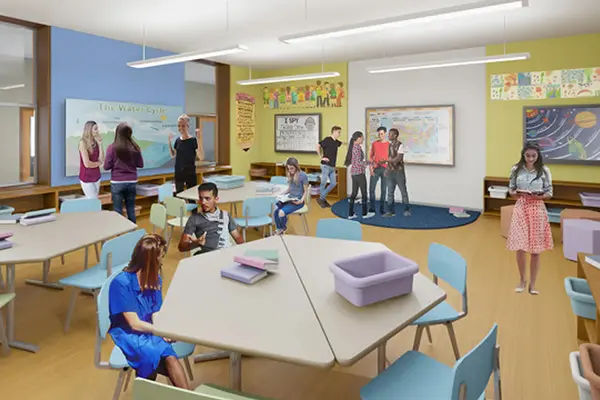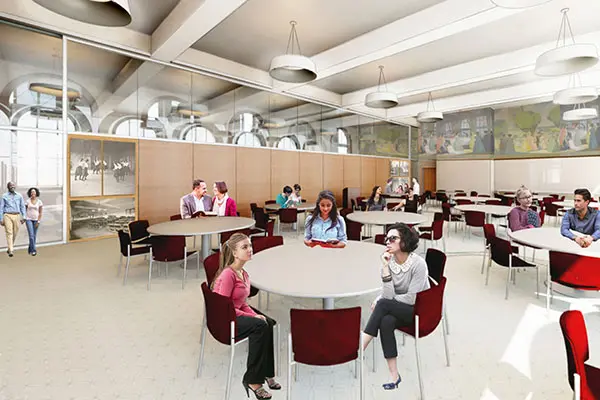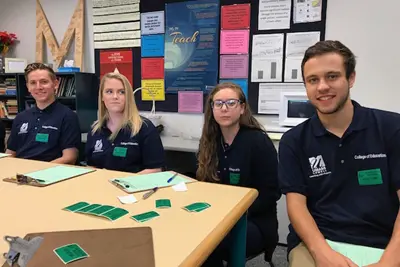College of Education Will Return to Historic Home, with Updates
 Image by Courtesy
Image by Courtesy
03/23/2018
By Katharine Webster
Coburn Hall is headed back to the future.
The College of Education will return in 2020 to its historic home in the earliest academic building on campus – after a top-to-bottom expansion and renovation, complete with updates that will help train the educators of tomorrow.
“We’re educating high-performing teachers, academic leaders and scholars who are ready to make a difference in children’s lives at every level,” says Dean Eleanor Abrams. “The Coburn Hall redesign will advance that mission by helping our students practice and apply educational innovations in schools today and in the future.”
The renovation and expansion go hand-in-hand with another big change: the return, after a 32-year hiatus, of the undergraduate teaching major. The first class of 18 students started last fall and will graduate in 2021 with dual certifications in elementary education and teaching children with moderate disabilities in pre-K through eighth grade.
The “new” undergraduate major is also a return to the college’s roots. Coburn Hall was built in 1897 to house the Lowell Normal School, a state teaching college. Over the years, the university has prepared hundreds of teachers for the classroom and provided advanced training to many more practicing teachers, school and district leaders and education scholars.
“The fact that we’re returning to the historic origins of teacher training in Lowell is fantastic,” says Prof. Anita Greenwood, who heads the new undergraduate program. “It’s exciting to be able to design with architects the space we want in a building that we love.”
 Image by Courtesy
Image by Courtesy
The model classroom will be outfitted with high-tech and low-tech elements, including modular furniture and wired work stations, a large interactive video screen, whiteboards and storage units. It will also have a small reading group corner, a circle for “circle time” and a sink and other facilities for science lessons.
“Flexibility is essential. No matter what type of lesson you design, you can easily configure the furniture the way you want it – open space, small group or traditional,” Greenwood says. “We want students to practice teaching in different settings.”
The design and discovery center will have more storage for hands-on materials and more modular furniture for group work. It will also have a screen, camera and microphones so students can record themselves as they practice introducing and teaching a lesson.
 Image by Courtesy
Image by Courtesy
Abrams, who grew up in rural Maine and researches innovative, community-based approaches to science education, says she also plans to add an ADA-compliant garden that will serve two purposes: one as a hands-on science lab, the other as an unplugged, natural setting where teachers can learn how to help their own students reduce stress and distractions to focus better on learning.
The renovation will preserve historic elements of the building, including the 1934 WPA-era murals of mill girls on either side of the front entrance. A matching mural that runs the length of the ballroom with three panels – students studying arts and humanities, the “ideal” teacher instructing a classroom of pupils and a view of Lowell’s skyline – will be restored after being painted over decades ago.
 Image by Courtesy
Image by Courtesy
The lowest level will feature eight general classrooms available to any department, including a “flipped” classroom for team-based and project-based learning. The third floor will be renovated as the new home for the Psychology Department, with faculty offices, a graduate student suite and research labs with observation rooms.
Abrams and the education faculty are especially pleased to be sharing a building with the Psychology Department. All education undergraduates must take an introductory class in psychology as well as Child and Adolescent Development before studying educational psychology, and many elementary school teachers earning their master’s degrees in curriculum and instruction obtain a graduate certificate in autism through the Psychology Department’s Autism Studies Program.
“Having that close proximity is just so important to us. The Psychology Department has several faculty members looking at other disabilities children have, and we have faculty studying them from an educational point of view,” Abrams says. “This whole child approach to learning will offer more opportunities for interdisciplinary research involving undergraduates, graduate students and faculty.”



